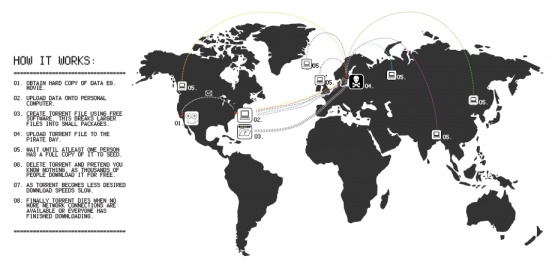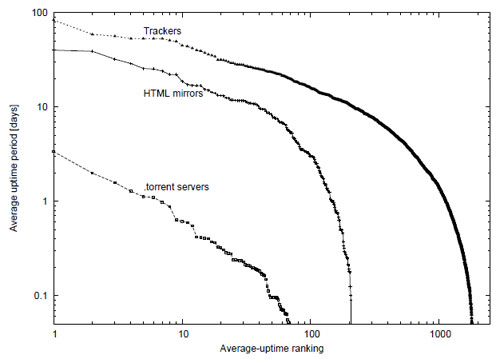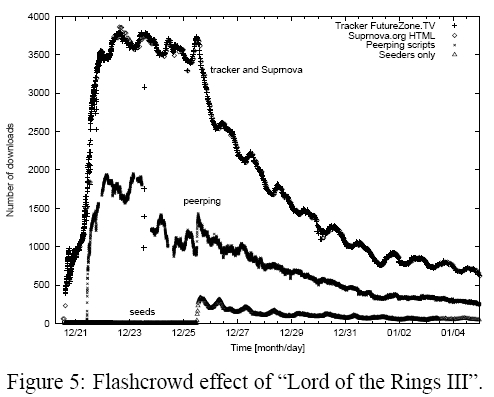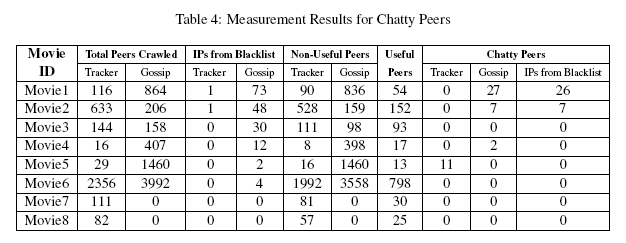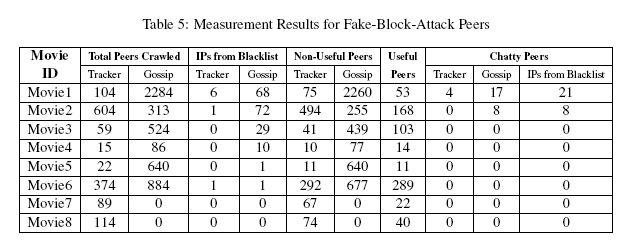The past few weeks have seen marked developments in piracy and file sharing. The Swedish Pirate Party, a political organization that strives to legalize file sharing and bolster internet privacy, scored a considerable victory on Sunday, securing at least one (but probably two) of Sweden’s eighteen European Parliament seats. In somewhat related news, my family discovered an incredible site where we could stream Stanley Cup games—valuable in spite of the decidedly-below-HD picture quality. My heart swelled with pride as I watched the Pittsburgh Penguins, my favorite team, skate their way to a game seven in Detroit, and I recalled the words to a pirate chantey from last month’s South Park episode about Somali swashbucklers. Cartman, or Captain Cartman, as he prefers to be called, leads four of his classmates-turned-crewmates to Mogadishu to live the pirate’s life, and when spirits are low, he breaks into song, “We drink and we pillage and we do what we please/ We get all that we want for free…”
Live streaming hockey only buffers my belief that virtually any form of data is available without charge if you know where to look for it. This is increasingly true, as BitTorrent indexes, tracking sites, and clients multiply by the minute. The European Parliamentary elections appear to be a microcosm of a broader shift: public opinion on file sharing and piracy seems to be catching up with evolving transfer technologies. In this post, I’d like to evaluate the schematics and efficacy of BitTorrent, which has become the preferred protocol for file sharing. I’d also like to consider public and interest group response to this topic, and the resultant operational impact on popular BitTorrent trackers, most notably The Pirate Bay.
How BitTorrent Works
Because BitTorrent is simply a file-sharing protocol without intrinsic search capacity for content, it is up to users to find .torrent files. The system relies on external components for file search, employs a moderator system to ensure the integrity of file data, and uses a bartering technique for downloading in order to prevent users from freeriding. In their essay “BitTorrent P2P File-Sharing System: Measurements and Analysis,” Pouwelse, Garbacki, Epema, and Sips highlight the elements that are necessary in a P2P system in order for it to be accepted by the larger community, “First, such a system should have a high availability. Secondly, users should (almost) always receive a good version of the content (no fake files). Thirdly, the system should be able to deal with flashcrowds. Finally, users should obtain a relatively high download speed.”[1]
After a peer has finished downloading the file, it may become a seed by staying online and sharing the file without bartering. The first concern, availability, is highly dependent on the willingness of peers to become seeds, sharing the data and proliferating the torrent swarm. The following table shows the results of Pouwelse, Garbacki, Epema, and Sips’ uptime measurements:
Here, peer uptime is plotted in hours after they have finished downloading, with peers ranked according to decreasing uptime. The longest uptime period is 83.5 days. This plot has been transformed using a log-log function, and shows an almost straight line between peer ten and peer 5,000. The sharp drop after 5,000 indicates that most users disconnect from the swarm shortly after the download has finished—within a few hours. The suddenness of the drop is important to note because the actual download of the data spans several days.
This chart ultimately demonstrates that seeds with a high availability are rare. Only 9,219 of 53,883 peers (17%) have an uptime longer than a single hour after they have finished downloading. Over a period of ten hours, this number decreases to only 1,649 peers (3.1%), and for 100 hours, to a mere 183 peers (0.34%). This data suggests that peers should be given increased incentives to lengthen their uptimes.
Pouwelse, Garbacki, Epema, and Sips also tried to evaluate the integrity of the medium by actively trying to pollute the system and then analyze the efficacy of these attempts. They write, “We created several accounts on different computers from which we tried to insert files that were obviously fake. We failed; the moderators filtered out our fake files.”[2]
The team also addresses their third concern: BitTorrent’s ability to handle flashcrowds, or the system’s reaction to the sudden popularity of a single new file. The figure shows the number of downloads for a single file as a function of time (the Lord of the Rings III movie, 1.87 GB):
The chart shows a gradual decrease over time, devoid of any sudden or unexpected drops or blips. This suggests that the system is able to comfortably handle the sudden popularity of a single popular movie, irrespective of how long, drawn out, and inferior to the original book that movie is.
Culture and Ethos of Piracy
Within P2P systems a tension exists between availability, which is improved when there are no global components, and data integrity, which benefits from centralization. BitTorrent seems to have struck a delicate balance, and is maintained through the decentralized work of a crew of dedicated pirates. In his essay “The Pirate Bay and the ethos of sharing,” Jonas Andersson explains that pirated products necessitate, “…labour which, at first glance, appears entirely unpaid: the late-night tinkering of crackers, encoders, subtitlers, administrators, seeders, leechers.”[3]Time and effort is needed on the part of these parties to facilitate the file-sharing network, but once it is in place, they too can benefit. In this sense, irrespective of incentives, file-sharing is governed by the law of equivalent exchange. File sharing, Andersson poses, “…is highly motivated by personal gratification and notions of comfort and instantaneity.”[4]
There remains, however, a decidedly altruistic element. There is an inherent and natural desire to augment and improve the internet, and the most effective way to do so is to make a personal contribution. Andersson writes, “This can be seen as a benevolent, humble intention which has roots deeply paralleled with the Internet ethos of free information exchange, distributed efficiency and adherence protocols.”[5]Copyright laws have made this culture of sharing problematic, however.
We are currently at a junction referred to by some commentators as ‘the grey commons’: uses of content are labeled either “copyright infringement” or “creative appropriation,” depending on who you consult. Rasmus Fleischer and Palle Torsson, the authors who coined the ‘grey commons’ description, categorize file sharing as a horizontal activity, “The only thing copyright can do is impose a moral differentiation between so-called normal workings and immoral.”[6]Their line of thinking works to blur the fundamental distinction between consumers and producers.
The idea of viewing media as a stream of data rather than divisible, extricable content facilitates the view of the grey zone as a radical blurring of distinctions between cultural consumers and producers. Andersson adds, “When the P2P enthusiasts label the work of fans, aficionados and boffins ‘production’ they are actually referring to what is still a phenomenon of consumption…,” albeit a consumption, “…so thorough, intense, dedicated that it goes into overdrive, becomes explicitly productive.”[7]
Productive consumption of this nature is more actively put into practice in some cultures than others. Japanesemangaka, the artists behind widely popular Japanese language comic books, often give out their personal addresses, encouraging readers to provide feedback that often has a real, substantive impact on the development of themanga. The industry also generally welcomes Dojinshi, or fan-published works that often include established characters and official plots. By allowing for highly participatory consumer involvement, the manga industry is actively blurring the line between production and consumption in an effort to release more accurately targeted products. After all, it is ultimately fans and consumers that determine the success of the product.
The only analogous American example I can think of is the production of Snakes on A Plane, a high-flying thriller that hardly needs an introduction, released by New Line Cinema in August of 2006. The film’s production team incorporated feedback from online users, and added five days of reshooting, garnering a significant amount of internet attention prior to its release. My friends and I were completely on board; we attended a raucous, sold out midnight showing of the film the night of its release. The film’s reshot version included a number of lines and scenarios that were inspired by the internet phenomenon, but one line stands out far above the rest. Here’s the SFW version of Samuel L. Jackson’s timeless quote:
The film’s gross revenue may not have lived up to its internet-generated hype, but Snakes on a Plane imparted a new alternative for consumer-entertainment industry relations, and a pretty cool T-shirt that I picked up at the mall the next day.
Attacks on Piracy
Perturbed by their inability to quell burgeoning BitTorrent clients, the entertainment industry has sought more viable alternatives. In their essay, “A Measurement Study of Attacks on BitTorrent Leechers,” Dhungel, Ross, Schonhorst, and Wu explain, “Given that it is currently difficult, if not impossible, to stop BitTorrent by suing companies, and that suing individual users is both painstaking and unpopular, the only remaining way to stop BitTorrent is via internet attacks.”[8]More specifically, the film and music industries have begun to hire anti-P2P companies to impede sharing of copyright-protected data. Dhungel, Ross, Schonhorst, and Wu analyzed the efficacy and quantity of anti-P2P attacks on BitTorrent systems by developing a crawler that contacts all peers in a given swarm, determines whether the swarm is under attack, and identifies the attacking peers in the swarm. The crawler was put to practice, analyzing torrent files of eight top box-office movies.
The team came across two principal attack types: the fake-block and uncooperative peer attacks. The former is used to prolong the download of the file by peers by pasting their download bandwidths. In the BitTorrent system, each file is divided into pieces, each about 256 KB, and each piece is typically divided into 16 blocks. A leech, when downloading a piece, requests different blocks from diverse peers. The attacker joins the swarm and advertizes that it has a large number of file pieces. Instead of transferring authentic blocks however, it sends fake ones, causing the victims’ eventual hash check to fail, requiring the peer to download the entire affected piece again. This event can occur ad nauseam, consistently stealing bandwidth from the victim peer.
The second variation, the uncooperative peer attack, is a bit more complex. In executing an uncooperative-peer attack, the attacker joins the targeted swarm and establishes TCP connections with a number of peers, but never provides any blocks to its victims. A common variant of this attack is the chatty peer attack, where the attacking peer speaks the BitTorrent protocol with a number of peers, advertising that it has a number of pieces of the file, but then refuses to transfer them to the victims. Every time a request is sent, the attacking peer resets its connection with the victims, and resends the handshake and bitmap messages.
The research team conducted passive measurements by repeatedly downloading a file suspected to be under attack, collecting multiple packet traces from hosts connected to both Ethernet and DSL access networks. The results recorded were for a torrent for “Echoes, Silence, Patience, & Grace,” an album from the Foo Fighters that had just been released, and was suspected to be under attack. This test was conducted on both Azureus and µTorrent, the two most widely used BitTorrent clients. The research team calculated a measure of delay using a delay ratio equal to the difference between the average download time with and without IP-filtering over the average download time with IP filtering. Their results are as follows:
Using an internally-developed packet parser, the team was able to attain a deeper understanding of the attack on Azureus and µTorrent clients. Using the parser, Dhungel, Ross, Schonhorst, and Wu were able to distinguish benevolent peers from those that were chatty, fake-block attackers, devoid of TCP connections or BT handshakes, and other peers that didn’t fall into previously listed categories. They found that, unlike on Azureus, fake-block attackers were present on µTorrent, but that on the latter client, benevolent peers made up a higher percentage of the swarm (22%, as opposed to 10% on Azureus).
Dhungel, Ross, Schonhorst, and Wu also actively detected chatty peers and fake-block-attack peers in torrents for top box-office movies using an internally developed crawler that traverses the BitTorrent network gathering IP addresses of peers for a given torrent. Their results are presented below:
Dhungel, Ross, Schonhorst, and Wu’s data suggests that anti-P2P companies can certainly prolong the average download time of immensely popular torrents, but the extent of this prolongation is typically modest and does not exceed 50%. This is hardly a problem for BitTorrent users, who often just leave their client running in the background or overnight. That said, blacklist-based IP filtering appears an insufficient filter mechanism. Dhungel, Ross, Schonhorst, and Wu agree, “To better filter out attackers, it is necessary to design smart online algorithms to identify different types of attackers.”[9]
The Pirate Bay Trial
On 17 April 2009, the Stockholm District Court found four people connected with The Pirate Bay, Sweden’s most infamous BitTorrent tracker, guilty of assisting in a form of copyright infringement. Each was sentenced to a year in jail and ordered to pay $3.7M in compensation and damages. The trial sent a strong message to the file-sharing community that, contrary to popular belief, tracker sites like The Pirate Bay are not immune from liability. Torrent trackers had become (and continue to be) widely accepted as mainstays of internet-based file transfer, so much so that the court’s ruling seemed almost surreal. Andersson explains, “What was so controversial about the raid against The Pirate Bay was—firstly—that it so clearly showed how out of tune the syndicated authorities and anti-file-sharing propagandists were in relation to the wider public, and how established, how everyday and normative, how casual and careless mass-scale file-sharing has become.”[10]
Some argue that the legal significance of the decision is likely limited, as it was decided under Swedish criminal law that is not harmonized across Europe. It’s true that Sweden is a unique case because of its sheer volume of file sharing: the country has the highest penetration of high-speed broadband-fiber connections in Europe. That said, the Pirate Bay Case in not an isolated incident. In September 2008, the Provincial Court of Madrid held that Sharemula.com, a torrent index site, and its administrators had not infringed any laws as the website merely linked to sources of illegal content rather than hosting it themselves.
In contrast, the Longroño (La Rioja) Criminal Court held in April 2009 that the site administrator of infopsp.com, another torrent tracking site, had indirectly profited from copyright infringement via advertising and SMS, and sentenced him to six months imprisonment and a fine. In his article, “The Pirate Bay case: repercussions beyond Sweden?,” Mark Young, an associate in the European intellectual property group, Covington & Burling LLP concludes, “…in the context of the various legislative developments in France, the UK, and in Brussels, regarding the responsibility of ISPs to cooperate with rights holders to prevent copyright infringement, the verdict can be regarded as a significant development in this ongoing battle.”[11]
Trial Aftermath, Pirate Party Sails to Victory
In the aftermath of the trial, many Swedes saw the authorities’ crackdown on The Pirate Bay as caving in to pressure from the American entertainment industry. This led to a timely surge of support for the Pirate Party, which repeatedly verbalized their support for the notorious tracker site, boosting the movement’s membership to 45,000. “‘We tripled our member count in a week,” Pirate Party founder and chairman Rickard Falkvinge said. [12]
Prior to the party’s nearly implausible success in the European Parliamentary elections, Falkvinge warned, “‘Politicians tend to look at the internet as a computer game that you can take away from the kids when they’ve been bad,’ Falkvinge said. ‘The time has come to understand information politics. That is why we are growing like a torrent.”’[13]His comments ring more true now than ever, as registered “pirate parties” have sprung up in Austria, Denmark, Finland, Poland and Spain and groups are attempting to register as political parties in the UK and the US.
A detained pirate, when asked by his captor, Alexander the Great, of his intentions, purportedly replied, ““What do thou meanest by seizing the whole earth?; but because I do it with a petty ship, I am called a robber, whilst thou who do it with a great fleet are a selfstyled emperor.” If piracy is truly a matter of scale, the entertainment and recording industries are standing at the helm of the Titanic, and they’ve had it with these monkey-fighting torrents on this Monday to Friday internet. The question persists: what can they really do about it?

